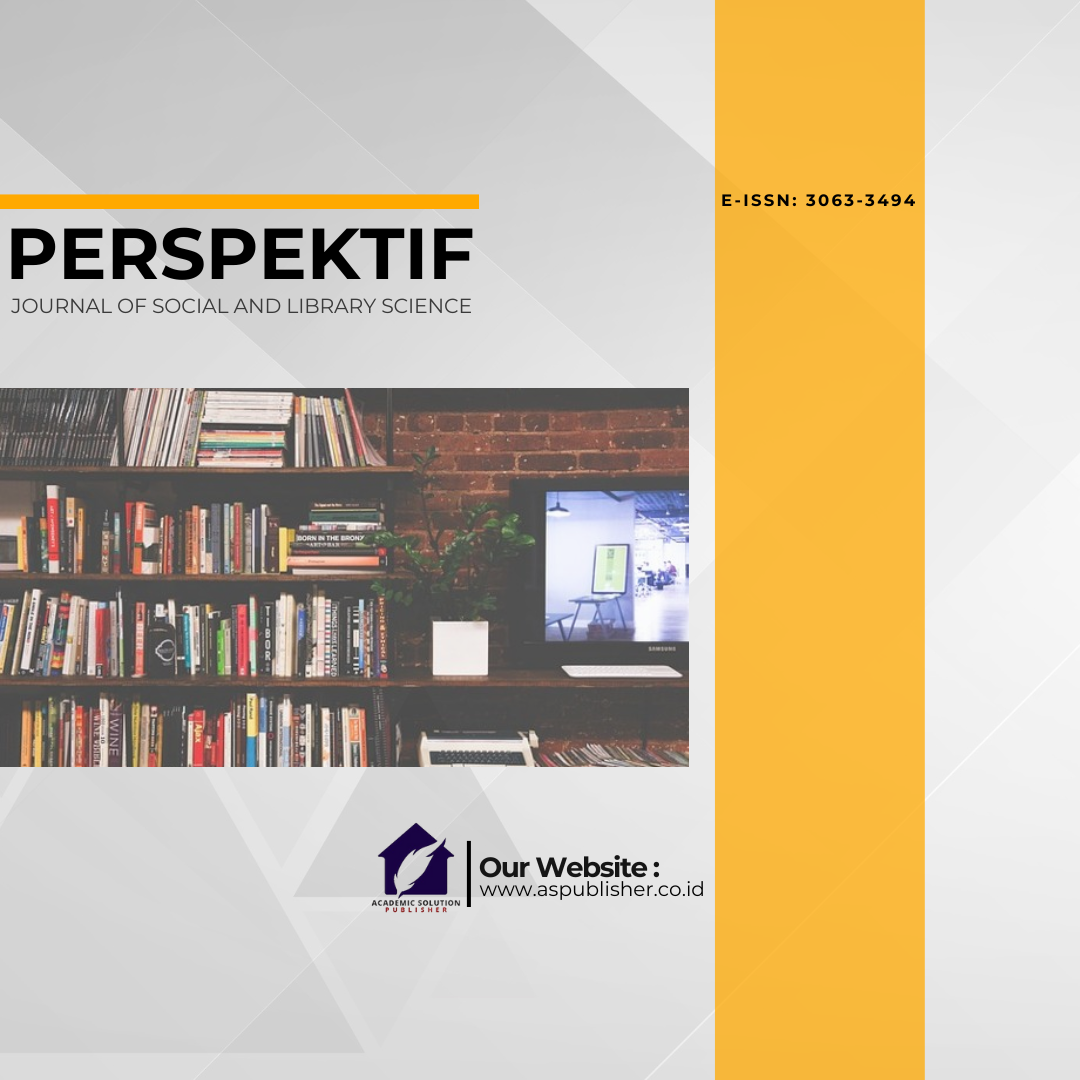LIBRARY OUTREACH STRATEGIES IN INCREASING USER PARTICIPATION IN PUBLIC LIBRARIES: A LITERATURE STUDY
DOI:
https://doi.org/10.70489/perspektif.v3i2.549Keywords:
Outreach Service Strategy, users or society , social media , technology , Digital Service, Public LibrarieAbstract
This study identifies that the growth of social media and the development of new technologies create significant opportunities for libraries to reach a broader audience. However, this also presents challenges, particularly among teenagers who tend to spend more time using their phones and interacting on social media platforms rather than reading or accessing literacy resources. Nevertheless, libraries can leverage social media as a tool to promote their services, expand the reach of information, and create interactive spaces that foster reading habits. This study also highlights the importance of libraries in supporting the development of information literacy skills, especially among higher education students. Through various creative approaches, such as establishing book clubs, providing user- centered learning spaces, offering virtual help desks, and using social media, libraries can actively contribute to improving access to information while encouraging reading habits among young people. Moreover, libraries have a significant influence on users' reading behavior by offering relevant collections, comfortable spaces, and innovative programs. To meet the ever-evolving expectations of users, libraries must continuously develop innovative outreach strategies. This includes integrating digital technology, organizing community-based activities, and collaborating with other institutions to enhance their impact on society. This study emphasizes that libraries can play a strategic role in advancing information literacy by remaining relevant to users' needs in the digital age. Thus, libraries can act as agents of change, supporting lifelong learning and strengthening the culture of literacy within communities. By adapting to technological advances and user demands, libraries can ensure their continued relevance and effectiveness in fulfilling their mission to educate, engage, and inspire.
Downloads
References
Strover , S. (2019). Public libraries and 21st century digital equity goals. Communication Research and Practice , 5 (2), 188-205.
Johnston, N. (2020). The shift towards digital literacy in Australian university libraries: Developing a digital literacy framework. Journal of the Australian Library and Information Association , 69 (1), 93-101.
Abayomi, OK, Adenekan, FN, Abayomi, AO, Ajayi, TA, & Aderonke, AO (2021). Awareness and perception of the artificial intelligence in the management of university libraries in Nigeria. Journal of Interlibrary Loan, Document Delivery & Electronic Reserve , 29 (1-2), 13-28.
Garner, J., Hider, P., Jamali, H.R., Lymn , J., Mansourian, Y., Randell-Moon, H., & Wakeling, S. (2021). 'Steady ships' in the COVID-19 crisis: Australian public library responses to the pandemic. Journal of the Australian Library and Information Association , 70 (2), 102-124.
Merga , M. K. (2020). School librarians as literacy educators within a complex role. Journal of Library Administration , 60 (8), 889-908.
Alajmi, B.M., & Albudaiwi, D. (2021). Response to COVID-19 pandemic: where do public libraries stand?. Public Library Quarterly , 40 (6), 540-556.
Libraria . (2023). Initiating the Role of Dissemination Knowledge on Services Search Information 'Say Hello Librarian ' at IAIN Kudus Library . Retrieved from https://libraria.fppti-jateng.or.id/index.php/lib/article/download/144/79/
Fisip Library Unmul . (2023). Innovation Strategy Samarinda City Library and Archives Service in Increasing Public Reading Interest . Retrieved from https://library.fisip-unmul.ac.id/cgi-bin/koha/opac-retrieve-file.pl?id=7e1df71f22e7fef216957dc7f4e245ac
Dennis, M. (2012). Digital Outreach Strategies for Libraries . Retrieved from https://repository.uinbanten.ac.id/15150/1/Layanan%20Perpustakaan%20As%20Instituti-.pdf
Cummings, S. (2007). Library Marketing and Outreach . Retrieved from https://repository.uinbanten.ac.id/15150/1/Layanan%20Perpustakaan%20As%20Instituti-.pdf
IFLA. (2016). Public Library Service Guidelines . International Federation of Library Associations and Institutions.
Johnson, P. (2018). Fundamentals of Collection Development and Management (4th ed.). American Library Association.
McCook, K. P. (2000). A Place at the Table: Participating in Community Building . American Library Association.
Pew Research Center . (2014). Libraries at the Crossroads . Retrieved from https://www.pewresearch.org
Smith, A.G. (2015). Digital Strategies in Public Libraries: Engagement and Outreach . Routledge.
Green, D.J. (2020). Community Engagement and Public Library Success: Strategies and Impact . Emerald Publishing.
Brown, T. L. (2019). Collaborative Innovations in Library Services . Springer.
Sharanappa , S. (2023). Role of libraries in promoting reading habits among users in higher education. International Journal of Education and Information Studies, 13 (1), 7–12.
Ravi, S. (2019). Outreach techniques in the promotion of library information services and resources: A study among LIS professionals. International Journal of Human Resource Management and Research (IJHRMR, 9 (2), 11–22.
Martinez, G. (2008). Public libraries – Community organizations making outreach efforts to help young children succeed in school. The School Community Journal, 18 (1), 93–104.
Aabo, S., & Audunson , R. (2012). How do public libraries function as meeting places? Library & Information Science Research, 34(1), 52–62. https://doi.org/10.1016/j.lisr.2011.07.007
Putnam, R.D. (2000). Bowling Alone: The Collapse and Revival of American Community . Simon & Schuster.
Rogers, E.M. (2003). Diffusion of Innovations (5th ed.). Free Press.
Wenger, E., McDermott, R., & Snyder, W. M. (2002). Cultivating Communities of Practice: A Guide to Managing Knowledge . Harvard Business Review Press.
Norman, D. A. (2013). The Design of Everyday Things: Revised and Expanded Edition . Basic Books
Downloads
Published
Issue
Section
License
Copyright (c) 2025 Muhammad Farid Bangun, Nabbila Indra Anjani, Putri Zulfati Wardina Anjani (Author)

This work is licensed under a Creative Commons Attribution-ShareAlike 4.0 International License.









